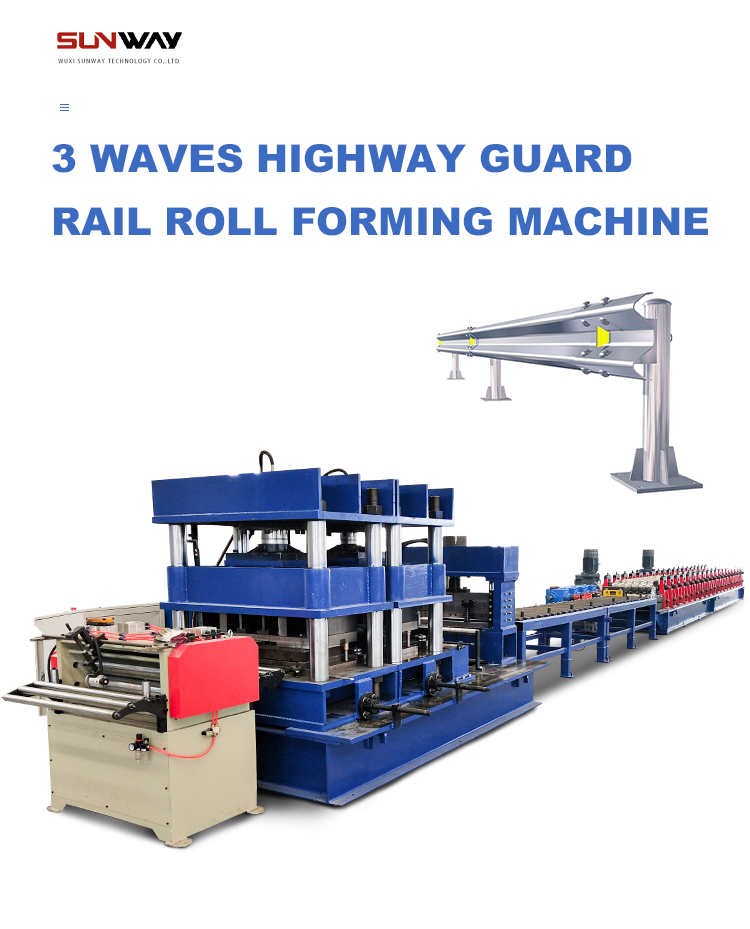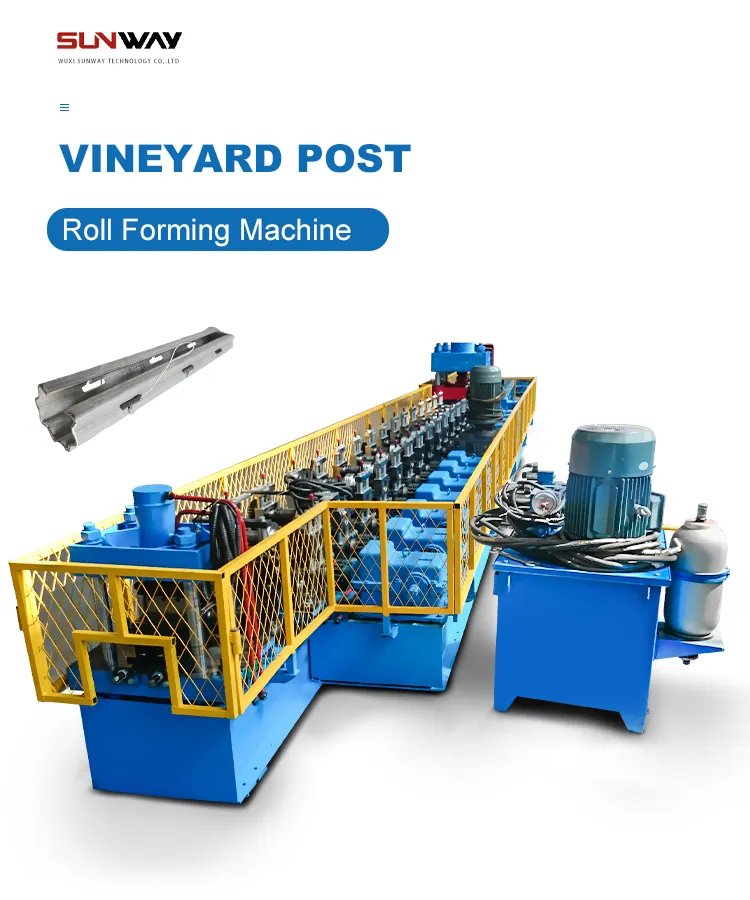ماكينات تشكيل أنابيب المطر الفولاذية الملونة تُستخدم في إنتاج أنابيب تصريف مياه الأمطار والمزاريب من لفائف معدنية مطلية مسبقًا بتشطيبات لونية مختلفة. هذه المكونات الحاملة للأمطار هي أجزاء أساسية من أنظمة تصريف مياه الأمطار للمباني.
يقدم هذا الدليل تفاصيل عن مواصفات أنابيب المطر، وأنواع ماكينات تشكيل اللفائف، والمكونات، ومبادئ العمل، وعوامل تصميم خط الإنتاج، والتطبيقات، والمزايا، والقيود، وغير ذلك.
لمحة عامة عن ماكينة تشكيل أنابيب المطر الفولاذية الملونة
تشمل الخطوات الرئيسية في تشكيل أنابيب المطر الفولاذية الملونة ما يلي:
- تغذية الملفات المعدنية المطلية في سلسلة من القوالب الدوارة
- ثني الشريط على البارد تدريجيًا على شكل أنابيب ومزاريب على البارد
- تشكيل المقاطع العرضية المستديرة أو المستطيلة أو نصف الدائرية
- قطع الأنابيب والمزاريب المضمنة بأطوال محددة
- التكديس التلقائي للمكونات الجاهزة
- ضوابط قائمة على نظام التحكم المنطقي القابل للبرمجة (PLC) للإنتاج المتزامن
عادةً ما يتم تشكيل لفائف الصلب المجلفن المطلي مسبقًا والألومنيوم والصلب المطلي بالسبائك في لفائف فولاذية مطلية مسبقًا في مكونات حاملة للمطر.

أنواع ماكينات تشكيل أنابيب المطر
هناك نوعان رئيسيان من قوالب تشكيل الأنابيب:
1. ماكينات تشكيل الأنابيب الدائرية
- تشكيل أقسام أنابيب المطر المستديرة
- استخدام طريقة التشكيل الحلزوني
- قطر الأنبوب عادةً 80-150 مم
- تصميم أبسط ومنخفض التكلفة
- سرعات حوالي 10-15 م/دقيقة
2. ماكينات تشكيل المزراب نصف الدائري
- إنتاج مزاريب نصف دائرية ومستطيلة الشكل
- طريقة التشكيل بالدلفنة التدريجي
- أجزاء تشكيل أوسع للملامح الأكبر حجماً
- تشغيل بسرعة 25-40 م/دقيقة
مقارنة بين أنواع لفة أنابيب المطر السابقة
| المعلمة | أنبوب دائري | مزراب نصف دائري |
|---|---|---|
| طريقة التشكيل | حلزوني | متسلسل |
| شكل الملف الشخصي | مستديرة | نصف دائري، مستطيل الشكل |
| نطاق الحجم | 80-150 مم قطر 80-150 مم. | 100-300 مم عرض 100-300 مم |
| سرعة الإنتاج | 10-15 م/دقيقة | 25-40 م/دقيقة |
| تكلفة الأدوات | أقل | أعلى |
مكونات خطوط أنابيب دحرجة أنابيب المطر
تتكون خطوط درفلة أنابيب المطر الفولاذية الملونة من وحدات معدات مختلفة:
آلة التفكيك
- تغذية الملفات الملونة في العملية
- مزودة بميزة التحكم في الشد
التغذية بالورق
- توجيه شرائح اللفائف وتقويمها
- مستشعرات مراقبة السُمك
محطات التشكيل بالدرفلة
- قوالب أسطوانية لتشكيل المقاطع الجانبية تدريجياً
- دعم البكرات والموجهات والمكابس
قطع الأنابيب
- القواطع الدوارة تقطع الأنابيب إلى شرائح بالطول
- تحكم مؤازر بمزامنة القطع
قطع المزراب
- شفرات القص تقطع المزاريب بالطول
- مشفرات قياس الطول
مكدس
- أنابيب ومزاريب منتهية التجهيز
- أحزمة تجميع الأشرطة
نظام التحكم
- لوحة تحكم PLC مع HMI
- المستشعرات، والمحركات المؤازرة، وأجهزة التعشيق الآمنة
الناقلات
- نقل قطع العمل بين المحطات
- الناقلات الأسطوانية الآلية
مبدأ عمل خطوط دحرجة أنابيب المطر
ينطوي مبدأ العمل على:
- فك لفائف الصلب المطلية مسبقًا في قسم التغذية
- تغذية الشريط من خلال القوالب الدوارة التدريجية
- ثني الشريط تدريجيًا في شكل أنبوب أو مزراب تدريجيًا
- تقطيع المكونات المشكلة حسب الطول بواسطة المقصات الدوارة
- التكديس التلقائي للأنابيب والمزاريب الجاهزة
- نظام التحكم المنطقي القابل للبرمجة PLC ينسق خط الإنتاج الآلي
يسمح التصميم المعياري بتغيير مجموعات البكرات لتبديل التشكيلات الجانبية. تحدد المعلمات مثل سُمك المعدن وأبعاد المقاطع الجانبية وسرعة الخط أبعاد الأدوات.
اعتبارات التصميم لخطوط أنابيب المطر المتدحرجة
عوامل التصميم الرئيسية لخطوط تشكيل الأنابيب المطرية المتدحرجة:
- أبعاد المنتج - أقطار الأنابيب وسُمك الجدار
- معلمات الشريط المعدني - عرض الملف، والمقياس، والقوة
- سرعة الإنتاج - قدم أو متر من الأنابيب المنتجة في الدقيقة
- متطلبات الأداء - الدقة ووقت التغيير
- مستوى الأتمتة - واجهة المشغل، السلامة
- لفة الأدوات - التصميم، والقدرة على التغيير السريع، والصلابة
- مناولة المواد - سعة اللفائف، والناقلات، وأجهزة التكديس
- قابلية التوسعة - القدرة على زيادة السعة المستقبلية
- البصمة الكلية - تخطيط ضمن المساحة المتاحة
تحدد مطابقة أهداف الإنتاج مع أبعاد أدوات المطر الحجم والتخطيط الأمثل للمكونات.
تطبيقات ماكينات درفلة أنابيب المطر الفولاذية الملونة
التطبيقات الرئيسية لأنابيب المطر والمزاريب المعدنية المدرفلة:
- أنظمة تصريف الأسقف
- فتحات تصريف مياه الأمطار لحصاد مياه الأمطار
- أنابيب الصرف للمناطق الخارجية
- مزراب للمركبات المتخصصة
- تصريف الأسطح الكبيرة غير السكنية
- جماليات معمارية مطابقة للألوان
- التطبيقات الساحلية/البحرية التي تحتاج إلى مقاومة التآكل
توفر مكونات أدوات المطر المطلية حماية من التآكل مع خيارات ألوان تتناسب مع التصميمات الخارجية للمبنى.
فوائد عملية دحرجة أنابيب المطر الفولاذية الملونة
مزايا عملية تشكيل أنابيب المطر المعدنية بالدلفنة:
- سرعات وأحجام إنتاج عالية
- عملية مستمرة من اللفائف
- دقة أبعاد متسقة
- تكاليف أقل مقارنة بالتصنيع التقليدي
- مجموعة واسعة من خيارات الألوان النهائية
- يحسن الإنتاج الآلي من الجودة
- توليد الحد الأدنى من الخردة
- يعمل التوريد في الوقت المناسب على تحسين المهل الزمنية
- المرونة في تغيير الأبعاد
- أكثر أمانًا من طرق البناء في الموقع
يوفر التشكيل الآلي بالدلفنة إنتاج مكونات الأدوات المطرية بكفاءة وفعالية من حيث التكلفة.
حدود درفلة أنابيب المطر الفولاذية الملونة
بعض القيود المفروضة على عملية تشكيل أنابيب المطر الفولاذية الملونة:
- استثمار أولي مرتفع للمعدات
- خطوط معدات مخصصة لكل ملف تعريف
- تصميم الأدوات المعقدة والتصنيع الآلي
- يتطلب فنيين مهرة للتشغيل
- خطر تشويش الملف إذا لم يتم التحكم فيه بشكل صحيح
- يقتصر على المقاطع المستقيمة فقط
- وقت تعطل تغيير الخط لتغيير الحجم
- متطلبات المساحة الكبيرة
- يمكن أن تكون مزعجة وتتطلب التخفيف من حدة الضوضاء
قد لا تكون العملية مجدية للإنتاج بكميات قليلة أو على دفعات.
الشركات المصنعة الرئيسية لمعدات دحرجة أنابيب المطر
تشمل بعض الموردين العالميين الرائدين لمعدات تشكيل أنابيب المطر الفولاذية الملونة ما يلي:
كبرى الشركات المصنِّعة لأنابيب المطر السابقة للفة أنابيب المطر
| شركة | الموقع |
|---|---|
| غاسباريني | إيطاليا |
| ميتفورم | الولايات المتحدة الأمريكية |
| شركة شنغهاي ميتال كوربوريشن | الصين |
| الدرفلة بالدرفلة من فويستالبين | النمسا |
| جوانيل | فرنسا |
| التشكيل بالدلفنة ABC | كندا |
| ماكينات سامكو | الهند |
وتوفر هذه الشركات معدات تشكيل لفة أدوات المطر القياسية والمخصصة. وتشمل خطوط الإنتاج الكاملة آلات فك اللفائف، وحوامل التشكيل، والتقطيع، والتكديس، ووحدات التعبئة والتغليف المجمعة.
نطاقات التكلفة النموذجية للمعدات
| سرعة الإنتاج | التسعير الإرشادي |
|---|---|
| 10 م/دقيقة | $100,000 – $250,000 |
| 25 م/دقيقة | $250,000 – $500,000 |
| 40 م/دقيقة | $4T500,000 - $1 مليون |
| 60 م/دقيقة+ | أكثر من $1 مليون |
تختلف الأسعار بناءً على سرعة الإنتاج وميزات الأتمتة وملحقات الخط.
إرشادات التثبيت والتشغيل
التدابير الرئيسية لتركيب وتشغيل خطوط تشكيل أنابيب المطر الفولاذية الملونة وتشغيلها:
- تخصيص مساحة أرضية لمناولة آمنة للمواد
- التثبيت والتسوية المناسبة للمعدات
- وصلات كهربائية وهوائية وهيدروليكية
- التشغيل التجريبي للتحقق من جودة المنتج
- توثيق معلمات التشكيل والإعدادات
- تدريب المشغلين على الإجراءات
- بروتوكولات السلامة مثل التعشيق المتداخل، والتوقف الإلكتروني
- جداول الصيانة الروتينية
- اتباع توصيات الشركة المصنعة
التركيب السليم، والتدريب على التشغيل والصيانة ضروريان لتحسين الإنتاجية والسلامة.
ممارسات الصيانة
أنشطة الصيانة الرئيسية لخطوط تشكيل أنابيب المطر الفولاذية الملونة:
- الفحص الدوري للمحركات الميكانيكية
- تشحيم المحركات، والمحامل، والتروس
- تنظيف أجهزة الاستشعار ومراقبتها
- فحص حالة أدوات البكرات
- شحذ/استبدال شفرات القص
- فحص المكونات الهيدروليكية والأنابيب
- التحقق من أجهزة الاستشعار ومعايرتها
- اختبار أجهزة التعشيق والتوقفات الآمنة
- مراقبة التهوية ودرجة الحرارة والضوضاء
- إصلاحات في الوقت المناسب لمنع التعطل غير المخطط له
تعمل الصيانة الوقائية المنتظمة على تحسين عمر المعدات ووقت تشغيل الإنتاج والسلامة.
اعتبارات اختيار معدات تشكيل أنابيب المطر
العوامل الرئيسية لاختيار معدات تشكيل أنابيب المطر بالدلفنة:
- الطاقة الإنتاجية - السرعات المقدرة تتطابق مع المتطلبات
- أبعاد الملف الشخصي - القدرة على إنتاج الأحجام المطلوبة
- مرونة أداة البكرات - تغيير سريع، تشغيل سهل وسريع
- معلمات المواد الخام - مناسبة لسُمك الملف المحدد
- أتمتة الخطوط - سهولة التشغيل والتحكم
- ميزات السلامة - التوقف في حالات الطوارئ، وقيود الوصول
- سمات الأداء - السرعة، والدقة، والمرونة
- معايير الجودة - اتساق الأبعاد
- دعم الخدمات - التركيب والتدريب والصيانة
- سمعة الموردين - خبرة وموثوقية مثبتة
- التكاليف - أسعار تنافسية لمستوى الأداء
يُنصح باختيار مُصنِّع راسخ قادر على تقديم الملامح المطلوبة في حدود الميزانية والمهلة الزمنية.

إيجابيات وسلبيات ماكينة تشكيل أنابيب المطر الفولاذية الملونة
المزايا:
- ارتفاع معدلات الإنتاج وأحجامه
- أبعاد متسقة ودقيقة
- انخفاض التكاليف التشغيلية
- توليد الحد الأدنى من الخردة
- مؤتمتة لمراقبة الجودة بشكل أفضل
- عمل أكثر أمانًا من تصنيع الموقع
- المرونة في تغيير الأحجام
- خيارات واسعة من ألوان التشطيبات
العيوب:
- ارتفاع النفقات الرأسمالية الأولية
- خطوط مخصصة لكل ملف تعريف
- القوى العاملة الماهرة المطلوبة
- خطر تشويش الملف
- تقتصر على المقاطع المستقيمة
- متطلبات المساحة الكبيرة
- وقت تعطل التغيير لتغيير الحجم
- يمكن أن تكون مزعجة وتتطلب التخفيف من حدة الضوضاء
الأسئلة الشائعة
ما هي المواد المستخدمة في أنابيب المطر؟
تشمل المواد الشائعة الفولاذ المجلفن المطلي مسبقاً والألومنيوم والفولاذ المطلي بالسبائك. توفر هذه المواد خيارات مقاومة للتآكل والتشطيبات اللونية.
ما هي العمليات المستخدمة لتصنيع أدوات المطر؟
عادةً ما يتم إنتاج أنابيب المطر والمزاريب عن طريق التشكيل الآلي للملفات المعدنية. وهذا يسمح بالإنتاج المستمر بكميات كبيرة.
ما هي فوائد أدوات المطر المعدنية مقابل البلاستيكية؟
يوفر المعدن قوة أعلى ومقاومة للصدمات وعمر خدمة أطول وجماليات أفضل مقارنةً بالبلاستيك. توفر المعادن المطلية خيارات ألوان.
ما هي الصيانة المطلوبة لأنابيب تشكيل أنابيب المطر؟
تنطوي الصيانة الدورية على فحص المكونات الميكانيكية وأدوات الدحرجة والمكونات الهيدروليكية وأجهزة الاستشعار وميزات السلامة. تقلل الصيانة في الوقت المناسب من وقت التعطل غير المخطط له.
ما هي تدابير السلامة المهمة لتشكيل الأنابيب بالدلفنة؟
تشمل تدابير السلامة الحرجة التوقف في حالات الطوارئ، والقيود المفروضة على الوصول، والأقفال المتداخلة، والحراس، وتدريب العمال، وتخفيف الضوضاء إذا لزم الأمر.
كيف تختار مورد معدات تشكيل أنابيب المطر؟
ضع في اعتبارك القدرة الإنتاجية وأتمتة الخط ومرونة اللفائف ودعم الخدمة والتكاليف. اختر مُصنِّعًا موثوقًا به ومناسبًا لأحجام الإنتاج وأحجام الأنابيب لديك.
ما هي معدلات الإنتاج التي يمكن أن تحققها مصانع درفلة الأنابيب؟
تتراوح السرعات النموذجية من 10 إلى 60 مترًا في الدقيقة حسب حجم الماكينة. يمكن لماكينات تشكيل البكرات الأكبر حجمًا المزودة بآلات فك اللفائف وأجهزة التكديس الآلية تحقيق معدلات إنتاج أعلى.
ما هي العوامل التي تحدد تكلفة معدات دحرجة أنابيب المطر؟
العوامل الرئيسية هي سرعة الإنتاج، ومستوى الأتمتة، وتصميم الأدوات، وملحقات الخط الإجمالية، واحتياجات التخصيص. تعتمد التكاليف أيضًا على العوامل الإقليمية.


